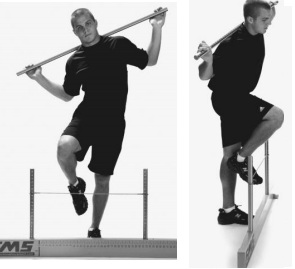After performing a large handful of assessments with our athletes at Cressey Sports Performance, one thing is very apparent: there is a trend of unilateral instability that is present.
How do I know? Well, I’ve been keeping track of these items in a fancy schmancy Excel sheet, and these things keep popping up! How these individuals arrived at a unilateral instability is also important, but from my point of view I am using the assessment process as a way to deliver high quality fitness and exercise selections.
Essentially, athletes (and general population as well!) are coming in with a predominantly strong pattern for favoring one side or the other.
A Few Thangs to Consider
1. As a strength coach and personal trainer, my responsibility is not aimed at ridding them of dysfunctional movement patterns – some of these dysfunctional movement patterns happen because of broken bones or surgeries, and it would be facetious for me think I can fix a bone! Rather, I’m all about improving upon their current fitness levels and referring out if necessary.
2. A lack of unilateral stability can mean: they need stability in a unilateral (or single leg/single arm fashion), or they need mobility in one area in order to stabilize in another area (providing more ability to move in an ankle or hip or even neck can clear up these issues).
3. If someone cannot perform single leg exercises in a dynamic fashion very well (Reverse Lunges, 1-Leg RDLs, etc.), I have to ask one question: why can you not perform this fundamental movement?

1. Lack of Ability to Split Pelvis in Efficient Manner
- If someone is extended, their pelvis may be tipped forward (think anterior pelvic tilt).
- If someone’s pelvis is tipped forward, forward and backward control of their pelvis may not be present.
- If forward/backward control is not present when standing, how much more will be present when asked to control ONE pelvis in opposition of the other pelvis moving in the other direction?

2. Lack of Reflexive Control (or Stability) via Abdominals
- If someone is extended, this lack of forward/backward motion may be attributed to lack of abdominal control.
- Obliques attach on PSIS and ASIS of pelvis.

If abdominals cannot control a pelvis, and pelvis is not used to controlling motion one hip at a time, well then that leads us down a path of a few exercises that keeps all of those items in mind!

With all this in mind, I find myself falling back on this exercise combination that will help initial trainees reintegrate training in a single leg and single arm fashion.
With the initial half kneeling exercise, you are getting a couple of great items:
1. A hip flexor stretch.
2. Ankle dorsiflexion on the back and down leg.
3. Requisite stability of the lower half of the body while moving your upper body.
4. Scapular motion (protraction/retraction) on the arm that is performing the rowing motion.
5. A static (or non-moving) neuromuscular pattern where you have to stabilize one pelvis in hip flexion and the other in hip extension, along with maintain abdominals and torso that requires stabilizing while rowing.
Why is this a better option than other rowing exercises?
Do you like chocolate? Feels good when you have some, right? Well performing rows (like barbell rows) are like chocolate. It’s good, but this is like adding in Graham crackers and smores. It adds in a little bit of nom, and a little bit of delish to the mix.

Long story short, this exercise allows you to perform a single leg static hold, while performing a rowing variation.
Why the variation for a side bridge?
Well this is a single variation, and you can perform this other variations to get a few more benefits:
1. Feet Elevated Side Bridge
2. Feet Elevated Side Bridge with Hip Abduction
4. Side Bridge with PNF Pattern
With that said, the side bridge (or side plank) variation will allow you to work on the abdominals, obliques, and hip stabilizers as well to improve unilateral stability by simply activating them!
How can you program these?
I’m so glad you asked. I usually perform these as a secondary exercise selection, so if you’re following along in the home program, these can be done as a B1/B2 exercise selection.
The movement is a secondary exercise, or accessory, or however else you want to call it. It can also be done as a warm-up, or even added into a circuit if you want to get a little crazy.
Sets and reps are variable as well, and rowing variations can usually be performed for 8 to 12 repetitions. Side plank variations can go anywhere from 20 to 30 seconds, or 5 to 8 respiratory cycles (inhales/exhales).
As always,
Keep it funky.

